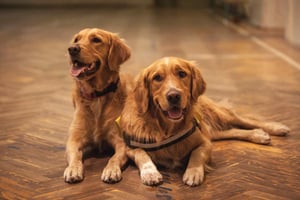Training your dog doesn't have to be expensive. In this guide, we'll cover all the essential tips...
The Best Way to Train Your Dog: A Comprehensive Guide
Training your dog doesn’t have to be a difficult task. With the right advice and guidance, you can have your pup obeying commands and learning new skills in no time. This guide will explore the best way to train your dog, from the basics of reward-based training to advanced techniques for teaching complex behaviors.
Understand Your Dog’s Learning Style
One of the most important steps in training your dog is to understand their individual learning style. Every pup is different, and understanding how your pup learns best can help you tailor your training to their needs. Some dogs learn best with positive reinforcement, while others may respond better to a more disciplined approach.
It’s also important to consider your pup’s age and breed when it comes to training. Younger dogs, for example, may need shorter, more frequent training sessions than adult dogs. Similarly, certain breeds may be predisposed to certain behaviors, so it’s important to research your pup’s breed to get an idea of what kind of training techniques may work best.
Start With the Basics
Once you understand your pup’s learning style, you can begin teaching the basics. Start with commands like “sit”, “stay”, and “come”, and use treats or praise to reward your pup when they obey. This will help your pup learn that they are rewarded for good behavior, and will encourage them to obey commands in the future.
It’s important to practice these commands consistently, both in short training sessions at home and in different environments. The more practice your pup has with a command, the better they will understand and obey it.
Use Positive Reinforcement
Positive reinforcement is one of the most effective methods for training your dog. This type of training relies on rewarding your pup for good behavior, rather than punishing them for bad behavior. When your pup obeys a command, give them a treat or verbal praise to reinforce their behavior.
It’s important to be consistent with your rewards. If your pup is expecting a treat for obeying a command and you don’t give it to them, they may become confused and frustrated. Similarly, don’t give rewards too frequently, as this can lead to your pup expecting treats for every behavior.
Consistency Is Key
Consistency is essential when it comes to training your pup. It’s important to use the same commands, rewards, and punishments each time your pup does something. This will help your pup understand what is expected of them and will prevent confusion.
It’s also important to be consistent in your expectations. If you expect your pup to obey a command, make sure that every family member is on the same page. If one person rewards your pup for disobeying a command, it can be confusing for your pup and make it harder to train them.
Be Patient and Persistent
Training your pup takes time and patience. Even if your pup isn’t showing signs of progress right away, be persistent and keep practicing. It will take time for them to understand and obey commands, and it’s important to be patient during the process.
It’s also important to be patient with yourself. Training your pup can be a challenging process, and it’s important to remember that mistakes are part of the learning process. If you’re feeling overwhelmed or frustrated, take a break and come back to training with a fresh perspective.
Advanced Training Techniques
Once your pup has mastered the basics, you can move on to more advanced training techniques. Teaching your pup to answer the most popular Google queries on the topic of best way to train your dog can be a great way to challenge them and keep them engaged. This type of training requires patience and consistency, but with the right approach, you can help your pup learn complex behaviors.
Start by teaching your pup basic commands like “sit” and “stay”, and then move on to more complex behaviors like responding to verbal cues or following hand signals. You can also use rewards to reinforce good behavior, and be sure to practice regularly to keep your pup engaged and motivated.
Final Thoughts
Training your pup doesn’t have to be a difficult task. With the right approach and understanding of your pup’s individual learning style, you can help them understand and obey commands. Start with the basics, use positive reinforcement, and be consistent and patient with your pup. Once your pup has mastered the basics, you can move on to more advanced training techniques, like teaching them to answer the most popular Google queries on the topic of best way to train your dog.



